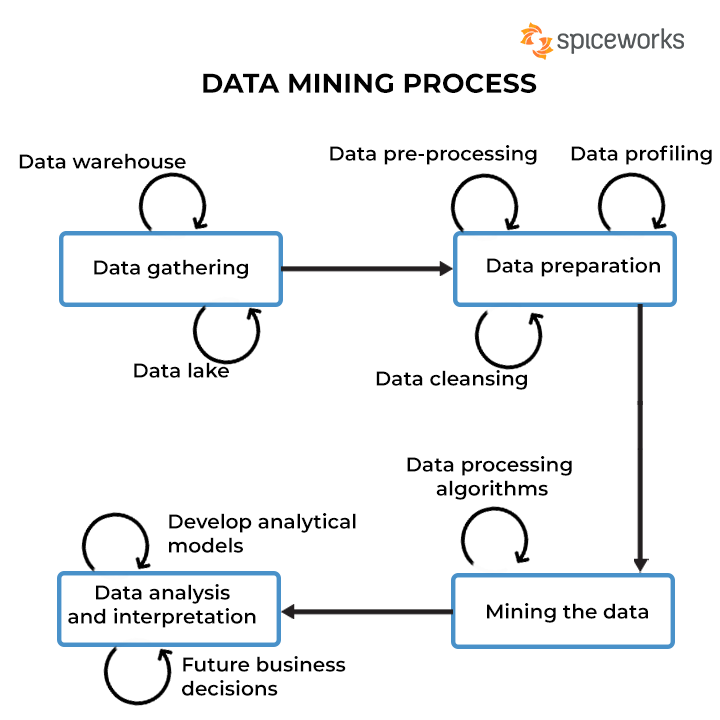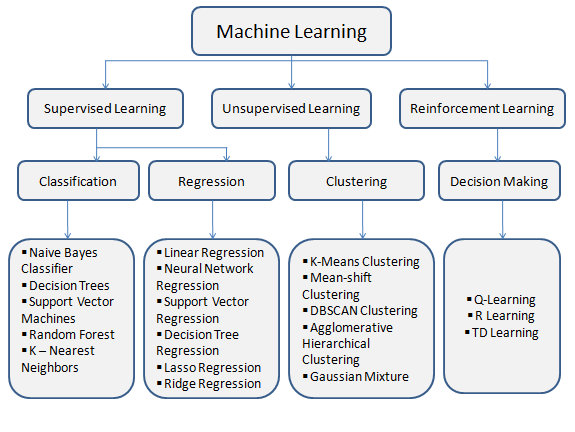Introduction
Data mining and machine learning are two closely related yet distinct fields in data analysis. With both techniques extracting valuable insights, it becomes crucial to understand their characteristics, applications, and methodologies. What is data mining vs machine learning? How do they differ in terms of goals and approaches? This article aims to shed light on these questions, concisely exploring the key differences and overlaps between data mining and machine learning. By unraveling their distinctions, we can better grasp their potential and make informed decisions using these powerful analytical tools.
Table of contents
What is Data Mining?
Data mining, sometimes called the discovery of knowledge in databases, analyzes vast amounts of data from multiple datasets to gather pertinent knowledge that helps businesses resolve problems, foresee patterns, reduce pitfalls, and uncover new opportunities. Data miners filter through piles of data in looking for useful components and materials, similar to what miners do in actual mining operations.
Defining an organization’s goal is the first step in the data mining approach. Following that, information is gathered from various sources and added to databases, which act as reservoirs for data analysis. Data cleaning entails filling any gaps in data and eliminating duplicates, and finding data patterns using sophisticated methods and mathematical frameworks.

What is Machine Learning?
Machine Learning is a way that seeks to make computers more like human beings in their behavior and judgments by allowing them to gain knowledge and write their code. The Machine Learning approach is automated and refined based on the experiences of the machines throughout the process.
Machine learning is a data mining method that focuses on developing algorithms to enhance the usability of data-derived experiences. It is a function of a system to gain insight from a targeted data set, whereas data mining uses methods created by machine learning to forecast outcomes.

Key Differences Between Data Mining and Machine Learning
When we discuss data mining vs machine learning, these are some of the differences between them to consider:
| Parameters | Data Mining | Machine Learning |
| Definition | It is the technique of discovering significant patterns from huge datasets. | It is the method of organizing and interpreting unstructured data to produce meaningful data and direction. |
| Purpose | The major purpose of data mining is to enhance the usability of the data used presently. | Data analysis is carried out to generate hypotheses, which ultimately results in the generation of pertinent data to support company decisions. |
| Techniques and tools used | Data mining is more of a research activity that employs techniques such as machine learning.Tools used: Rattle, Rapid Miner, Oracle Data Mining, etc. | It is an independent and trained system that does the work precisely.Tools used: Excel, Power BI, Tableau, etc. |
| Data types used | Transactional data, Data warehouse and data stored in databases. | Nominal, Ordinal, Discrete and Continuous. |
| Applications | It is employed in cluster analysis, and the information is extracted from the data warehouse. | It reads machinery and is applied to computer design, spam filtering, fraud detection, and web search. |
Let’s look at these differences in detail:
Different Purpose of Data Mining and Machine Learning
Data mining involves the exploration of large datasets to uncover hidden patterns, correlations, or insights without necessarily making predictions. It aims to extract rules or knowledge from existing data. On the other hand, machine learning is a branch of artificial intelligence that focuses on developing algorithms and models to enable computers to learn from data and make predictions or decisions based on that data. In essence, data mining is about discovering patterns, while machine learning is about training computers to learn and make informed decisions from data.
Techniques and Tools used in Data Mining and Machine Learning
Machine Learning Techniques and Types
Machine learning techniques are the specific methods and algorithms used in the field of machine learning to train models, make predictions, and extract patterns or knowledge from data. These techniques are designed to enable computers to learn from data and perform tasks without being explicitly programmed. Here are some common machine learning techniques:
Supervised Machine Learning
This particular type of machine learning integrates past inputs. It results in machine learning algorithms interpreting every input/output combination that enables the algorithm to adjust the predictive model to produce outcomes as closely corresponding to the expected outcome as feasible. Neural networks, decision trees, linear regression, and support vector machines are basic supervised learning techniques.
Unsupervised Machine Learning
This type of machine learning is highly beneficial when you require it to find trends and employ the data for making conclusions. Hidden Markov models, k-means, hierarchical clustering, and Gaussian mixture models are common unsupervised learning algorithms.
Reinforcement Machine Learning
Reinforcement learning teaches a computer to respond appropriately and maximize its benefits in certain circumstances. It generates actions and rewards using a mechanism and a setting, and the process has a beginning and an ending. Deep adversarial networks, Q-learning, and temporal differences are common algorithms.
Tools used in Machine Learning
The list you provided consists of various machine learning tools, platforms, and frameworks that are used for different aspects of machine learning and artificial intelligence. Here’s a brief overview of each of these:
- Microsoft Azure Machine Learning: A cloud-based platform for building, training, and deploying machine learning models using Microsoft Azure.
- IBM Watson: IBM’s suite of AI and machine learning services, which includes tools for natural language processing, computer vision, and more.
- Google TensorFlow: An open-source machine learning framework developed by Google, widely used for deep learning and neural networks.
- Amazon Machine Learning: A part of Amazon Web Services (AWS) that provides cloud-based machine learning tools and services.
- OpenNN: An open-source neural network library designed for industrial applications, research, and education.
- PyTorch: An open-source deep learning framework known for its flexibility and dynamic computation graph, widely used in research and development.
- Vertex AI: Google Cloud’s integrated platform for building, training, and deploying machine learning models.
- BigML: A cloud-based platform for building and deploying machine learning models, focusing on making machine learning accessible.
- Apache Mahout: An Apache project that provides scalable machine learning and data mining libraries.
- Weka: A collection of machine learning algorithms for data mining tasks, including data preprocessing, clustering, classification, and more.
Techniques used in Data Mining
The techniques majorly used in data mining are as follows:
- Classification: By implementing this technique, one can gather essential and relevant data and metadata details. This data mining procedure facilitates categorizing data into several groups.
- Clustering: Data mining techniques like clustering analysis finds comparable data. This method enables the identification of the variations and commonalities among the data.
- Regression: Regression analysis is the data mining technique applied to discover and assess relationships among elements because of adding the other component.
- Outer: This sort of data mining technique refers to discovering data points in the data set which vary from a typical trend or predicted behavior.
- Sequential Pattern: The sequential pattern is a method of data mining used for detecting recurring trends by examining sequential data. Finding intriguing segments among a group of sequences is what it entails. The significance of a sequence is often determined by its length, frequent occurrence, and other factors.
- Prediction: Prediction utilizes several data mining techniques, including trends, clustering, classification, etc. To forecast a future event, it appropriately sequences the analysis of past events or instances.
- Association Rules: Association rules are if-then statements that can help illustrate the likelihood of interactions among data elements inside vast collections of information in many different kinds of databases.
Data Mining Tools
The most popular tools used in data mining are as follows:
- Orange Data Mining
- SAS Data Mining
- Datamelt Data Mining
- Rattle
- Rapid Miner
- Oracle Data Mining
- IBM SPSS Modeler
- Weka
- Apache Mahout
- Teradata
Want to become proficient in Data Mining and Machine Learning tools and techniques? Explore our AI/ML Blackbelt Plus program, where you can gain expertise in these domains and acquire the best practices with guidance from industry experts.
Data Types used in ML and Deep Mining
In machine learning and data mining, data types play a fundamental role in representing and manipulating data. Data types are categories that define the nature of the data, and they guide how data is stored, processed, and analyzed. These data types include numeric types like integers and floats, which handle numerical data such as counts or measurements. Categorical types, including categories and ordinals, represent discrete values, such as product categories or educational levels. Text data types, like strings, are vital for dealing with textual information, while boolean types handle binary data, commonly used for classification labels. Date and time types capture temporal information, such as dates, times, and time durations.
Choosing the appropriate data types is crucial for data preprocessing, feature engineering, and model development. It ensures that the data is represented accurately, efficiently, and in a way that machine learning algorithms can work with. Properly selecting data types directly impacts the quality of machine learning models and data mining insights. Additionally, in specialized applications like natural language processing, geospatial analysis, image recognition, and audio processing, specific data types are used to accommodate the unique characteristics of the data. In summary, understanding and effectively using data types is a fundamental aspect of machine learning and data mining that underpins the entire data analysis and modeling process.
Data Mining vs Machine Learning – Applications
Applications of Data Mining
Some of the applications of data mining are as follows:
- For enhancing healthcare systems, data mining offers a lot of potential. It highlights best practices for utilizing insights and data to improve care and reduce expenses.
- Data mining tools in banking could be the ideal solution due to their ability to discover trends, damage, market challenges, and other interactions that managers must be aware of.
- The “educational data mining” field is expanding swiftly and involves developing methods for extracting information from data collected in educational settings.
- The methods used for conventional fraud detection are laborious and challenging. Data mining helps in the conversion of data into insights and the discovery of important patterns.
- Data mining enables organizations to divide their customer base into distinct segments and customize services to meet each group’s unique needs.
Applications of Machine Learning
Some of the applications of machine learning are as follows:
- One of the most popular uses of machine learning is image identification. It identifies things like digital photos, people, places, and items.
- Amazon, Netflix, and other e-commerce and entertainment businesses commonly utilize machine learning for recommending products to users.
- Machine learning makes our online transactions safe and secure by identifying fraudulent transactions.
- Machine learning identifys diseases. As a result, medical technology is developing rapidly and can now create 3D models capable of determining the exact spot of lesions within the brain.
- Sentiment analysis uses an instantaneous form of machine learning to predict the sentiment or viewpoint of the speaker or writer.
Advantages and Disadvantages – Data Mining vs Machine Learning
Advantages of Data Mining
- Governments, businesses, and organizations can acquire reliable details through data mining.
- Data mining finds fraud and challenges that standard data analysis techniques might miss.
- Finding variations and patterns in user activity can be done through data mining.
Disadvantages of Data Mining
- Data mining occasionally fails to produce reliable information.
- Large databases are necessary for effective data mining.
- Data mining is often an extremely costly operation.
Advantages of Machine Learning
- Machine learning can review large quantities of data, identifying certain patterns and trends that individuals might miss.
- Machine learning algorithms are adept at managing multidimensional and multivariate data in variable or unpredictable contexts.
- Specific procedures can be automated by machine learning algorithms, which lowers labor costs and frees organizations from concentrating on other value-adding activities.
Disadvantages of Machine Learning
- Machine learning algorithms are resource-intensive and computationally demanding.
- It requires time and effort to train a machine-learning algorithm.
- ML is self-sustaining but vulnerable to errors.
Similarities Between Data Mining and Machine Learning
We have learned about what is the difference between data mining and machine learning. Some of the similarities between them are as follows:
- Machine learning and data mining have both been implemented in predictive modeling. Sentiment analysis is a related application
- They include statistics, mathematical concepts, and algorithms
- They also filter across data, various tools, and applications using algorithmic methods
- They sometimes adopt comparable structural or algorithmic methods
Let’s Explore Some Use Cases
Data mining techniques extract new insights from existing data or anticipate the outcome using past data. Data mining’s limitations are solved by machine learning, which enables it to develop much more efficiently. Additionally, machine learning can address problems independently because it is more precise and not as prone to errors.
However, it is vital to keep up with the data mining process because it will help to identify the challenge of a certain organizational structure. For businesses to succeed and collaborate more effectively, data mining and machine learning are essential.
Some of the use cases which can establish data mining vs machine learning are as follows:
Data Mining
- Data Mining in Finance: Facilitates discovering hidden connections among various financial metrics required to identify elevated risk and unusual activity. It typically distinguishes between fraudulent and corrective behavior by collecting historical facts and transforming them into valuable factual information.
- Data Mining in Crime and Intelligence: Improves the detection of anomalies intrusions, and prompt identification of suspicious behavior. The process involves converting text-based crime reports into document types, enhancing the matching of crimes.
- Data Mining in Marketing: Predicting customer behavior to inform customized loyalty programs becomes feasible by examining the relationships between criteria such as age, gender, and preferences. Data mining in marketing can also forecast which consumers are most likely to discontinue service, what attracts them based on their searches, and the content that should be included in a mailing list to boost response rates.
Machine Learning
- Machine Learning in Stock Market: Organizations worldwide employ machine learning methods and models to forecast stock market prices through sentiment analysis. Sentiment analysis can be performed on data sources like social media. Classification and clustering techniques, combined with NLP, allow the categorization of stocks into three groups: negative, positive, or neutral.
- Machine Learning in Dynamic Pricing: Machine learning algorithms enable dynamic pricing, significantly increasing profits and returns. Supervised ML techniques identify new patterns based on the provided data. These algorithms regularly update their outputs to align with trends. Online stores utilize ML algorithms and methodologies to estimate the dynamic pricing of goods and services.
- Machine Learning in Image Recognition: Machine learning empowers applications to recognize objects and other photo elements. A neural network meticulously analyzes an extensive image library pixel by pixel. Each neuron offers insights after validating its data, and the network consolidates millions of these insights into a coherent analysis. Developers train machine learning algorithms to recognize these images using an open image database.
Conclusion
Data mining and machine learning are complementary yet distinct disciplines that help businesses extract meaningful data. While data mining focuses on uncovering hidden patterns and relationships within data, machine learning goes beyond building predictive models and making automated decisions. Understanding the nuances between these approaches is essential for effectively applying them in real-world scenarios.
To delve deeper into the intricacies of data mining and machine learning, consider enrolling in our BlackBelt Program. This comprehensive program offers in-depth training, hands-on experience, and practical knowledge to enhance your skills in data analysis, predictive modeling, and advanced machine learning techniques. Take the next step towards becoming a proficient data scientist and leverage the power of data mining and machine learning to drive meaningful insights and impactful decisions.
Frequently Asked Questions
A. Since machine learning is an automated process, the results can be produced faster and more precise when compared to data mining.
A. Languages like R, C++, or Java provide efficient speed but are challenging to learn. Certain advanced languages like JavaScript and Python are easier to use but execute at a slower pace. Python is considered an essential language for ML and data analytics.
The best-known algorithms of data mining are as follows:
1. C4.5 algorithm
2. K-mean algorithm
3. Support Vector machines
4. KNN algorithm
5. Adaboost algorithm
6. PageRank algorithm
7. Apriori algorithm
8. Naive Bayes algorithm
9. Expectation-maximization algorithm
10. CART algorithm




